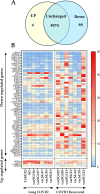A blood-based mRNA signature distinguishes people with Long COVID from recovered individuals
- PMID: 39691709
- PMCID: PMC11649547
- DOI: 10.3389/fimmu.2024.1450853
A blood-based mRNA signature distinguishes people with Long COVID from recovered individuals
Abstract
Introduction: Long COVID is a debilitating condition that lasts for more than three months post-infection by SARS-CoV-2. On average, one in ten individuals infected with SARS CoV- 2 develops Long COVID worldwide. A knowledge gap exists in our understanding of the mechanisms, genetic risk factors, and biomarkers that could be associated with Long COVID.
Methods: In this pilot study we used RNA-Seq to quantify the transcriptomes of peripheral blood mononuclear cells isolated from COVID-recovered individuals, seven with and seven without Long COVID symptoms (age- and sex-matched individuals), on average 6 months after infection.
Results: Seventy genes were identified as significantly up- or down-regulated in Long COVID samples, and the vast majority were downregulated. The most significantly up- or downregulated genes fell into two main categories, either associated with cell survival or with inflammation. This included genes such as ICOS (FDR p = 0.024) and S1PR1 (FDR p = 0.019) that were both up-regulated, indicating that a pro-inflammatory state is sustained in Long COVID PBMCs compared with COVID recovered PBMCs. Functional enrichment analysis identified that immune-related functions were expectedly predominant among the up- or down-regulated genes. The most frequently downregulated genes in significantly altered functional categories were two leukocyte immunoglobulin like receptors LILRB1 (FDR p = 0.005) and LILRB2 (FDR p = 0.027). PCA analysis demonstrated that LILRB1 and LILRB2 expression discriminated all of the Long COVID samples from COVID recovered samples.
Discussion: Downregulation of these inhibitory receptors similarly indicates a sustained pro-inflammatory state in Long COVID PBMCs. LILRB1 and LILRB2 should be validated as prospective biomarkers of Long COVID in larger cohorts, over time and against clinically overlapping conditions.
Keywords: COVID-19; LILRB1; LILRB2; Long COVID; biomarker; inflammation; transcriptomics.
Copyright © 2024 Missailidis, Ebrahimie, Dehcheshmeh, Allan, Sanislav, Fisher, Gras and Annesley.
Conflict of interest statement
The authors declare that the research was conducted in the absence of any commercial or financial relationships that could be construed as a potential conflict of interest. The author(s) declared that they were an editorial board member of Frontiers, at the time of submission. This had no impact on the peer review process and the final decision.
Figures





Similar articles
-
Comprehensive transcriptome assessment in PBMCs of post-COVID patients at a median follow-up of 28 months after a mild COVID infection reveals upregulation of JAK/STAT signaling and a prolonged immune response.Front Immunol. 2025 May 30;16:1589589. doi: 10.3389/fimmu.2025.1589589. eCollection 2025. Front Immunol. 2025. PMID: 40519915 Free PMC article.
-
A systems biology approach unveils different gene expression control mechanisms governing the immune response genetic program in peripheral blood mononuclear cells exposed to SARS-CoV-2.PLoS One. 2024 Dec 5;19(12):e0314754. doi: 10.1371/journal.pone.0314754. eCollection 2024. PLoS One. 2024. PMID: 39637135 Free PMC article.
-
Comparative Transcriptomic Analyses of Peripheral Blood Mononuclear Cells of COVID-19 Patients without Pneumonia and with Severe Pneumonia in the First Year of Follow-Up.Viruses. 2024 Jul 28;16(8):1211. doi: 10.3390/v16081211. Viruses. 2024. PMID: 39205185 Free PMC article.
-
Long COVID or Post-Acute Sequelae of SARS-CoV-2 Infection (PASC) and the Urgent Need to Identify Diagnostic Biomarkers and Risk Factors.Med Sci Monit. 2024 Sep 18;30:e946512. doi: 10.12659/MSM.946512. Med Sci Monit. 2024. PMID: 39289865 Free PMC article. Review.
-
Towards understanding post-COVID-19 condition: A systematic meta-analysis of transcriptomic alterations with sex-specific insights.Comput Biol Med. 2024 Jun;175:108507. doi: 10.1016/j.compbiomed.2024.108507. Epub 2024 Apr 22. Comput Biol Med. 2024. PMID: 38657468
Cited by
-
Long COVID-19: A Concept Analysis.Infect Dis Rep. 2025 Jul 29;17(4):90. doi: 10.3390/idr17040090. Infect Dis Rep. 2025. PMID: 40863252 Free PMC article.
References
MeSH terms
Substances
LinkOut - more resources
Full Text Sources
Medical
Miscellaneous

